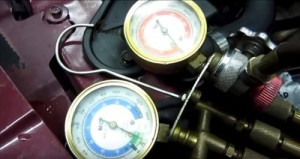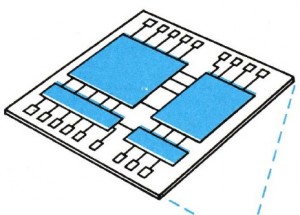
Refrigeration and air conditioning are not discoverers of the twenty first or even the twentieth century. Simple forms of refrigeration and air conditioning were in use twelve thousand years ago.
Although these early systems were crude by today’s standards, they served the same purpose as modern units.
Many aspects of modern life were made possible only after sophisticated air-conditioning systems were developed.
Numerous vital components associated with the United States space program could not have been manufactured without the use of air conditioning. For example, many precision mechanical parts must be manufactured and assembled under very strict tolerances.
These tolerances require the control of temperature and humidity within a range of a few degrees. For example, this microprocessor chip, only about 1/16 inch square, is a miniaturized electronic circuit etched into a base of silicon.

It was manufactured in a temperature/humidity-controlled environment made possible by modern refrigeration techniques.
Automotive air conditioning was available in 1940, but it did not become popular until 1960. Since that time, interest in air conditioning has in-creased yearly.
When air conditioning was first used in automobiles, it was considered a luxury. Its usefulness soon made air conditioning a necessity. At this point, the definition of air conditioning should be reviewed before tracing its history and its application to the automobile. Air conditioning is the process by which air is cooled, cleaned, and circulated. In addition, the quantity and quality of the conditioned air are controlled. This means that the temperature, humidity, and volume of air are controlled in any given situation. Under ideal conditions, air conditioning can be expected to accomplish all of these tasks at the same time. It should recognize that the air-conditioning process includes the process of refrigeration (cooling by re-moving heat).
COST OF OPERATION
It is the general opinion of many that the ever-increasing cost of fossil fuel will put an early end to the “luxury” of automotive air conditioning.
The air-conditioning system does place an extra load on the engine. Any engine load requires fuel. Therefore, it seems apparent that the use of an air conditioner will reduce gasoline mileage. This is true, but only for stop-and-go driving. At highway speeds, air-conditioned cars, with their windows closed and the air conditioning operating, actually average two to three percent better mileage than do non air-conditioned cars. The aero-dynamic design considerations of the car body are based upon having the windows closed. When the windows are closed, it seems that reduced wind resistance offsets the demand load of the air-conditioning system on the engine.
As EXXON published in its Happy Motoring News® (Vol. 19), “At 40 mph or faster you’ll use more gasoline by driving with your windows open than you will by operating an air conditioner with all the windows closed. Open windows cause that much ‘drag’.” The number of new car sales has decreased in recent years. However, the percent of new cars sold with air-conditioning systems has remained about the same. Aftermarket sales, service, and re-pairs on automotive air conditioners have actually increased to some extent. Car owners are simply keeping their cars longer, and in better repair.
THE SERVICE TECHNICIAN
How does all this affect the student of automotive air conditioning? As the popularity of air conditioning in vehicles increases, it is obvious that the need for installation, maintenance, and service technicians will also increase. Many shops that just a few years ago added air-conditioning service as a sideline, now find it to be their primary business. The air-conditioning technician must have a thorough working knowledge and understanding of the operation and function of the circuits and controls of the automotive air conditioner. A good knowledge of the equipment, special tools, techniques, and skills of the trade is also essential. Air conditioning has made it possible for the Space Age to become part of the twentieth century. What was fiction at the turn of the century is commonplace today. The service technician’s contribution to the industry may help make today’s fiction commonplace by the twenty-first century.
SAFETY
It must be recognized that the procedures used by technicians performing automotive service vary greatly. It is not possible to anticipate all ways or conditions under which service may be performed. Therefore, it is not possible to provide precautions for every conceivable hazard that may result. The following precautions, then, are basic and apply to any type automotive service. 1. Wear safety glasses or goggles for eye protection.
2. Set the parking brake. Place the gear select in park (automatic transmissions) or neutral (manual transmissions).
3. Be sure the ignition switch is in the OFF position, unless otherwise required for the procedure.
4. When required for the procedure, operate the engine only in a well-ventilated area.
5. Keep clear of all moving parts when the engine is running. Remove rings, watches, and loose-hanging jewelry. Avoid loose clothing. Tie long hair securely behind the head.
6. Keep hands, clothing, tools, and test leads away from the radiator cooling fan. Electric cooling fans can start without warning even when the ignition switch is in the OFF position.
7. Avoid contact with hot parts such as radiator, exhaust manifold, and high-side refrigeration lines.